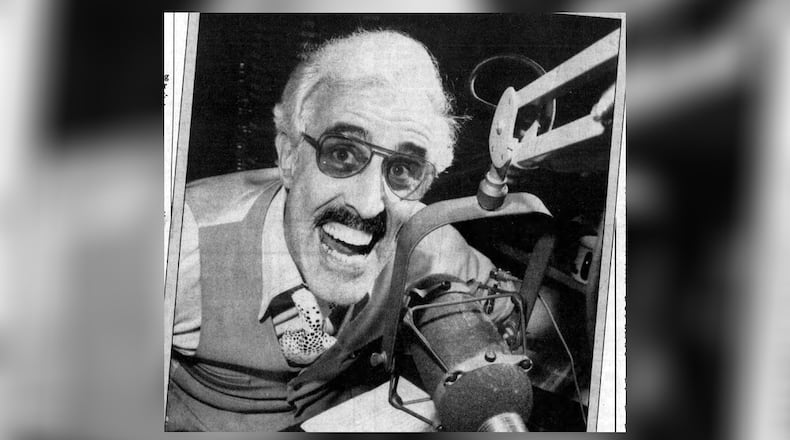His on-air delivery style was described as flamboyant, boisterous, crazy, frenetic and just plain loud. We remember him after his death was reported earlier this week, just before his 92nd birthday
Getting his start
Stephen Andrew Kirkpatrick, better known by his audience as Steve Kirk, grew up in Holyoke, Mass.
After graduating from Springfield College, his mother wanted him to be a police officer, but he failed the written exam three times. He then went on to Catholic University of America in Washington, D.C. to get his masters in Physical Education.
During that time, Kirk traveled to Bellaire, Ohio, with his roommate, who had aspirations for a career in radio. Kirk accompanied him for an interview at WTRX-AM. The roommate didn’t end up getting the job, but Kirk did.
At first, he only filled in for the morning folks when they went on vacation. Then, when the afternoon person quit, the morning DJ took that spot and opened the morning spot up for Kirk. He was making $235 a month.
Two years later, he moved to WCOL-AM in Columbus.
Kirk was known for being loud. In a 1985 interview with the Dayton Daily News, he said, “I’ve always been loud. When I worked at a station in Columbus, an engineer there said all we had to do was open the windows and we’d have 5,000 more watts.”
Five years after that he moved on to WSAI-AM in Cincinnati. Then on Labor Day in 1966, Dayton heard his famous catchphrase, “Hi gang, Kirkie here” for the first time on WING-AM.
WING-AM (1410)
In the 1970s s and ‘80s, Kirk became the most recognizable media personality in town. He was on WING radio in the morning. He did commercials and could always be counted on to make personal appearances at local events.
“I figure I did 14,000 hours of public appearances — everything from sock hops to charity fundraisers,” he once said. “I did it for the exposure. and as a way of saying ‘thank you’ to my audience. I loved my listeners.”
“I think he’s been blessed as a natural comedian,” WKEF’s Johnny Walker, a friend of Kirk’s, once said. “He says stuff that just doesn’t make sense sometimes and you laugh. If I said it or you said it, it would sound stupid. He’s the kind of guy who can tell you the same joke 50 times and you’d still laugh at it because of the way he tells it.”
How did he become so popular? Kirk thought of two answers: “First, I have a positive attitude. I never get on the air and moan and complain. People out there have 30,000 more problems than you do. They don’t want to hear yours. And, second, I’m myself. What people hear at 5 a.m. on the air is what they hear in my apartment at 2 p.m.”
In 1983 the Dayton Daily News published a story about Steve Kirk leaving Dayton radio after being at WING for 17 years. He said he was resigning to become owner of WGFB-AM, a radio station in Webster, Massachusetts, 35 miles from where he grew up.
In the end, Kirk was given a substantial raise to stay at WING, and did so until retiring on Labor Day in 1991, 25 years to the day of when he started.
He usually signed off his shows saying, “I’ll be back in the morning, the good Lord willing.”
Attempted comeback
After a brief retirement, WYMJ-FM station officials announced that Steve Kirk had been hired to take over their morning show.
He made his debut on April 13, 1992, but his rating never went as high as he thought they would. By Nov. 13, Kirk was no longer working at the station and retired for good.
Odds and ends
In 1972, Kirk and WING released an album titled “Steve Kirk’s Put-Ons.” Kirk was known for phoning local politicians and celebrities and capturing their reactions on the air. The album contained his 12 best pranks.
WKEF (Channel 22) had a program called “Steve Kirk’s Late Night Theater.” It featured mostly off-the-cuff live banter and taped comedy segments with a movie.
Kirk twice brought the Beatles to Cincinnati and also booked the Rolling Stones into Hara Arena in 1965.
“It was the band’s first Dayton-area appearance,” he said, “but only 3,500 people came to the show.”
Kirk told the Dayton Daily News when he was inducted into the Ohio Radio-TV Broadcasters Hall of Fame in 1999: “Just think, me and Phil Donahue in the Hall of Fame. I never thought it was possible.”
In the 1983 Dayton Daily News “Best and Worst” edition, readers voted in a variety of categories.
In “Best disc jockey/talk master,” the winner was Steve Kirk.
In “Worst disc jockey/talk master,” the winner was Steve Kirk.
“I loved it,” Kirk said. “Half of them love me and half of them hate me. But they all remember Steve Kirk.”
About the Author






